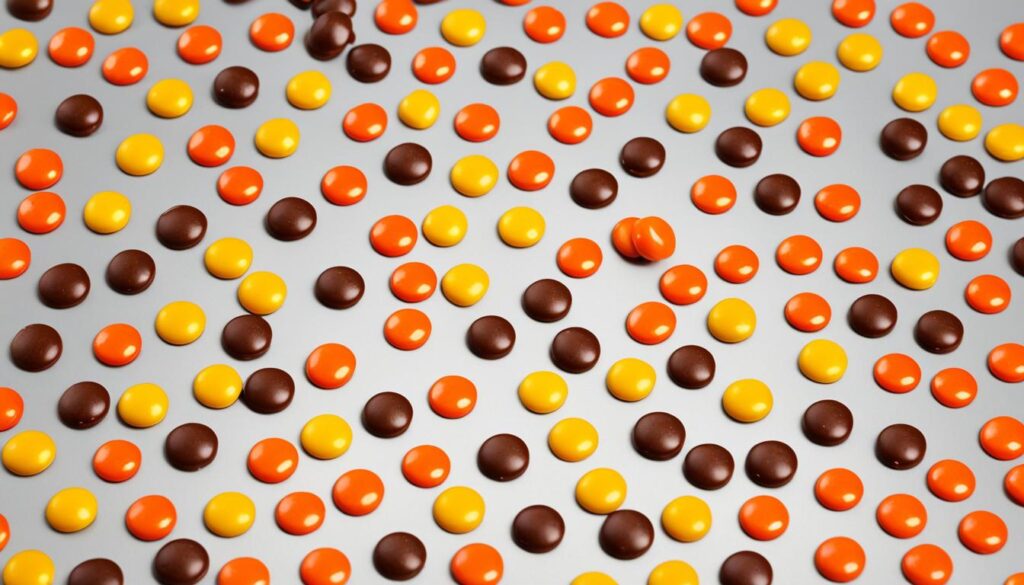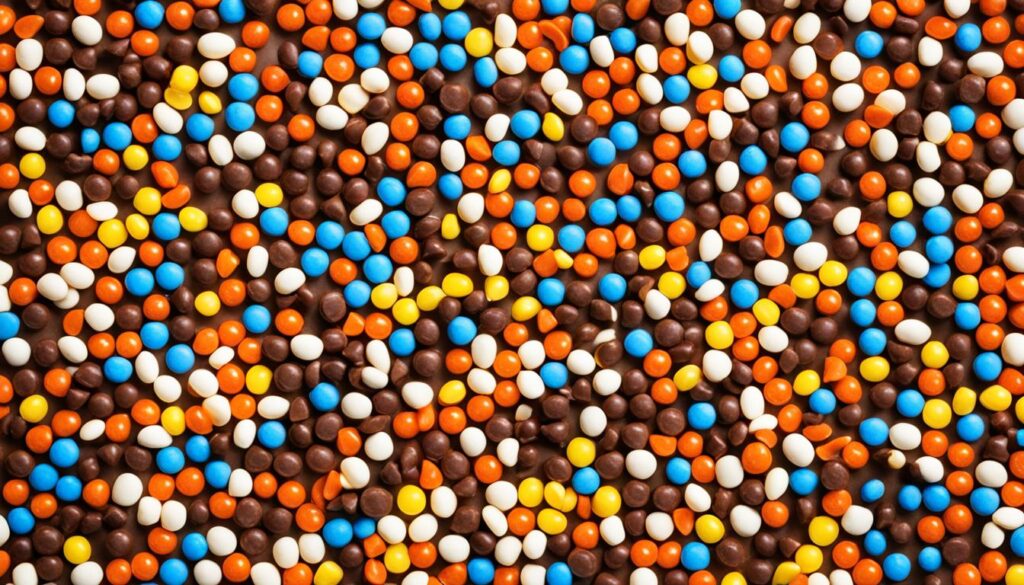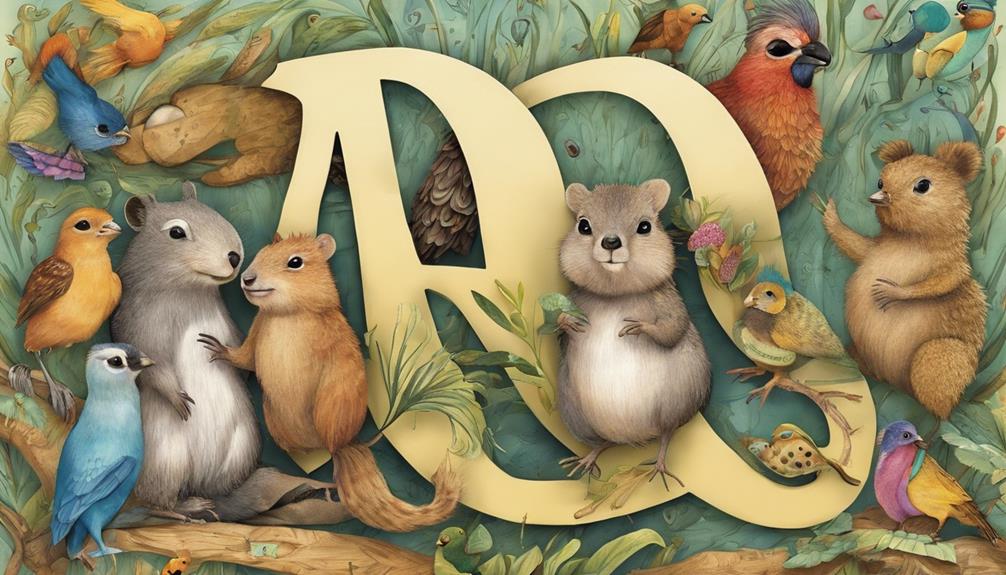Did you realize that over 55 million households in the United States have a dog? That’s a significant number of furry pals! If you own a dog, it’s common to want to give them delicious treats. However, it’s crucial to be mindful of what we give them to keep them healthy and happy.
One popular treat that many dog owners wonder about is Reese’s Pieces. Can dogs indulge in these tiny peanut butter candies or are they better off sticking to their regular dog treats? Let’s dig deeper into the topic and find out the risks associated with feeding Reese’s Pieces to dogs.
Key Takeaways:
- While dogs can have a few Reese’s Pieces as an occasional treat, it is not recommended to feed them regularly or in large quantities.
- Reese’s Pieces contain high levels of sugar, which can lead to issues such as obesity, dental problems, and diabetes in dogs.
- The artificial flavors, colors, and other ingredients in Reese’s Pieces may cause gastrointestinal upset or food sensitivities in dogs.
- Opt for healthier and dog-friendly treats that are specifically formulated for their dietary needs.
- Monitor your dog for any signs of allergies or adverse reactions, and consult with your veterinarian regarding their diet and treat options.
Can Dogs Have Reese’s Pieces?
While dogs can have Reese’s Pieces in small amounts as an occasional treat, it is not recommended to regularly give them to dogs. The high sugar content can contribute to obesity, dental issues, and diabetes in dogs. Additionally, the artificial flavors, colors, salt, and milk in Reese’s Pieces can cause gastrointestinal upset or exacerbate food sensitivities in dogs. It is best to opt for healthier and dog-friendly treats for your furry friend.

The Risks of Feeding Reese’s Pieces to Dogs
Feeding Reese’s Pieces to dogs can pose several risks to their health. One of the main concerns is the high sugar content in these candy treats. Dogs are not built to handle large amounts of sugar and consuming excessive amounts can lead to weight gain, obesity, and related health issues like diabetes.
Furthermore, the artificial flavors, colors, salt, and milk in Reese’s Pieces can be problematic for dogs. These ingredients can cause gastrointestinal upset, such as diarrhea or vomiting, and may exacerbate food sensitivities in some dogs. It is always best to stick to treats that are specifically formulated for dogs and avoid giving them human treats that contain potentially harmful ingredients.
When giving your dog an occasional treat, it’s important to prioritize their overall health and well-being. Opt for treats that are made with natural ingredients and are specifically designed for dogs. This way, you can ensure that they are getting a safe and enjoyable treat without compromising their health.
| Risks of Feeding Reese’s Pieces to Dogs | Healthy Alternatives for Dogs |
|---|---|
|
|
“It’s essential to remember that treats should only make up a small portion of your dog’s overall diet. The majority of their nutrition should come from a balanced and appropriate dog food.”
What Are Reese’s Pieces?
Reese’s Pieces is an iconic American candy that has been delighting taste buds since its introduction in 1978. While it shares similarities with its famous sibling, Reese’s Peanut Butter Cups, Reese’s Pieces offer a unique twist on the classic combination of peanut butter and chocolate. These delectable treats consist of small, flat circular candies coated in vibrant candy shells, creating a visually appealing and irresistible snack.
The primary ingredients in Reese’s Pieces include partially defatted peanuts, sugar, corn syrup solids, hydrogenated vegetable oil, dextrose, and a delightful blend of artificial flavors and colors. While the absence of chocolate sets Reese’s Pieces apart, their irresistible peanut butter filling provides the same rich and creamy experience that fans love. Each bite-size candy bursts with a perfect balance of sweetness and nutty goodness, making them a beloved treat for candy enthusiasts of all ages.
| Ingredients in Reese’s Pieces |
|---|
| Partially defatted peanuts |
| Sugar |
| Corn syrup solids |
| Hydrogenated vegetable oil |
| Dextrose |
| Artificial flavors and colors |
As a delightful blend of ingredients, Reese’s Pieces offer a unique taste experience that has captured the hearts of candy lovers around the world. The combination of sweet, nutty peanut butter and the satisfying crunch of the candy shell is simply irresistible. Whether enjoyed as a standalone treat or used in baking and desserts, Reese’s Pieces add a burst of flavor that brings joy to any occasion.

History of Reese’s Pieces
“Reese’s Pieces revolutionized the candy industry with its bold and innovative take on peanut butter treats in the late 1970s. Created by The Hershey Company, Reese’s Pieces quickly gained popularity and developed a dedicated following.
- Inspiration from the success of Reese’s Peanut Butter Cups
- Introduction of Reese’s Pieces in 1978
- Feature in the iconic movie E.T. the Extra-Terrestrial
- Continued success and popularity worldwide
Reese’s Pieces became a cultural phenomenon when they starred in Steven Spielberg’s blockbuster film, E.T. the Extra-Terrestrial, released in 1982. The candy’s appearance in the movie propelled it to even greater fame and solidified its status as an American classic. Since then, Reese’s Pieces have remained a beloved treat, continuing to bring joy to candy connoisseurs everywhere.
Ingredients in Reese’s Pieces
Curious about what goes into Reese’s Pieces? Let’s take a closer look at the main ingredients of this popular candy.
The primary components of Reese’s Pieces include:
| Ingredient | Description |
|---|---|
| Partially defatted peanuts | High-quality peanuts that have had some of their natural fats removed |
| Sugar | Sweetener used to enhance the taste of the candy |
| Corn syrup solids | Dried form of corn syrup that provides sweetness and helps bind the ingredients together |
| Hydrogenated vegetable oil | Including soybean oil and palm kernel oil, this oil adds a smooth texture to the candy and prevents separation of other ingredients |
| Dextrose | A type of sugar that is easily digestible and contributes to the candy’s sweetness |
| Artificial flavors and colors | Additives that enhance the taste and appearance of the candy |
While Reese’s Pieces are generally safe for human consumption, it is important to note that some ingredients in this candy may not be suitable for dogs.
It’s crucial to be aware of any potential harmful ingredients in Reese’s Pieces when considering giving them to your furry friend.

Please note that while Reese’s Pieces do not contain toxic ingredients like chocolate or raisins, there are other factors to consider when it comes to feeding them to your dog, especially if your furry friend has specific dietary needs or allergies.
What Happens If My Dog Eats Too Many Reese’s Pieces?
If a dog accidentally consumes excessive amounts of Reese’s Pieces, it can lead to various health issues due to the high fat and sugar content. Each piece of Reese’s Pieces contains approximately 80% sugar and fat, which can have negative effects on a dog’s well-being.
Eating too many Reese’s Pieces can result in immediate symptoms such as vomiting, diarrhea, constipation, or abdominal pain. These digestive issues can cause discomfort and distress in dogs, requiring veterinary attention in severe cases.
Moreover, the long-term consequences of excessive Reese’s Pieces consumption can have lasting effects on a dog’s health. The high sugar content can contribute to obesity, leading to additional health problems such as diabetes, heart disease, and pancreatitis.
It is essential to keep Reese’s Pieces out of reach of dogs and ensure they are not given these treats in excessive quantities. Instead, opt for healthier alternatives that are specifically formulated for dogs, providing them with the necessary nutrients without the risks associated with excessive sugar and fat intake.

| Effects of Eating Too Many Reese’s Pieces | Risks of Excessive Reese’s Pieces Consumption | Health Issues from Eating Reese’s Pieces |
|---|---|---|
| Vomiting | Obesity | Diabetes |
| Diarrhea | Heart Disease | Pancreatitis |
| Constipation | ||
| Abdominal Pain |
Conclusion
In conclusion, while dogs can have a few Reese’s Pieces as a treat once in a while, it is not advisable to make them a regular part of their diet. The high sugar content and other potentially harmful ingredients in Reese’s Pieces can lead to various health issues for dogs, including obesity, dental problems, and diabetes.
Instead of feeding your dogs Reese’s Pieces, it is important to opt for healthier treats that are specifically formulated for their dietary needs. There are many dog-friendly treats available in the market that provide the right balance of nutrition and flavors without the risks associated with high sugar content.
As responsible dog owners, it is essential to monitor our four-legged friends for any signs of allergies or adverse reactions. If you notice any unusual symptoms after giving your dog Reese’s Pieces or any other treat, consult with your veterinarian to ensure their well-being and to explore safer treat options.
Remember, our dogs rely on us to make the best choices for their overall health and happiness. By choosing healthier treats and being mindful of potential risks, we can ensure that our canine companions enjoy a long, vibrant, and fulfilling life.










